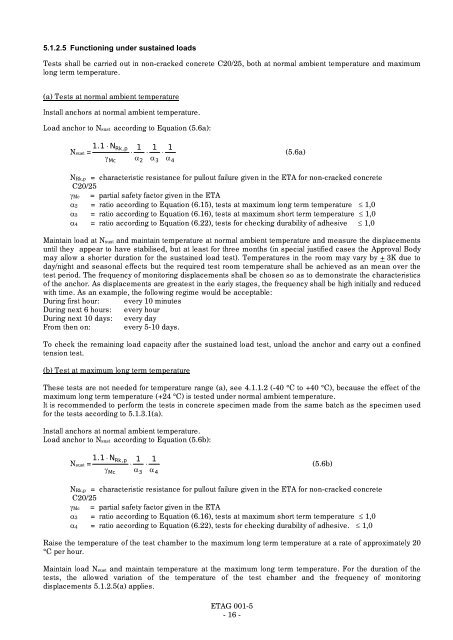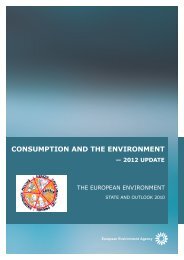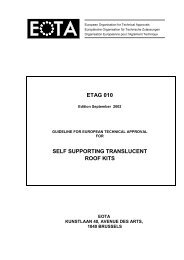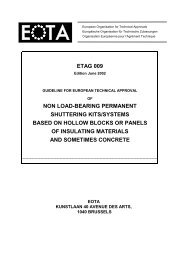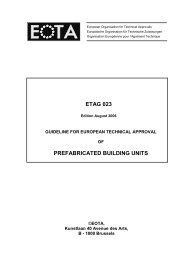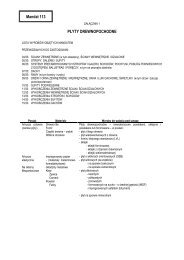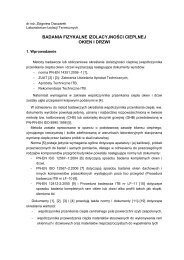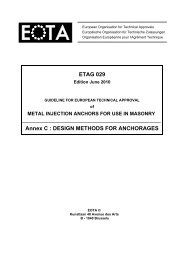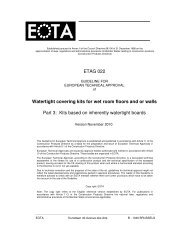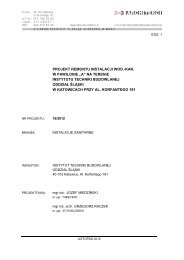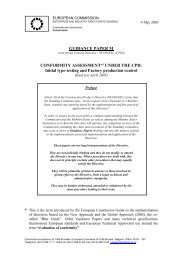5.1.2.5 Functioning under sustained loadsTests shall be carried out in non-cracked concrete C20/25, both at normal ambient temperature and maximumlong term temperature.(a) Tests at normal ambient temperatureInstall anchors at normal ambient temperature.Load anchor to Nsust according to Equation (5.6a):Nsust =1.1 N Rk,pMc1 12 13 4(5.6a)NRk,p = characteristic resistance for pullout failure given in the ETA for non-cracked concreteC20/25Mc = partial safety factor given in the ETA2 = ratio according to Equation (6.15), tests at maximum long term temperature 1,03 = ratio according to Equation (6.16), tests at maximum short term temperature 1,04 = ratio according to Equation (6.22), tests for checking durability of adhesive 1,0Maintain load at Nsust and maintain temperature at normal ambient temperature and measure the displacementsuntil they appear to have stabilised, but at least for three months (in special justified cases the Approval Bodymay allow a shorter duration for the sustained load test). Temperatures in the room may vary by + 3K due today/night and seasonal effects but the required test room temperature shall be achieved as an mean over thetest period. The frequency of monitoring displacements shall be chosen so as to demonstrate the characteristicsof the anchor. As displacements are greatest in the early stages, the frequency shall be high initially and reducedwith time. As an example, the following regime would be acceptable:During first hour: every 10 minutesDuring next 6 hours: every hourDuring next 10 days: every dayFrom then on: every 5-10 days.To check the remaining load capacity after the sustained load test, unload the anchor and carry out a confinedtension test.(b) Test at maximum long term temperatureThese tests are not needed for temperature range (a), see 4.1.1.2 (-40 °C to +40 °C), because the effect of themaximum long term temperature (+24 °C) is tested under normal ambient temperature.It is recommended to perform the tests in concrete specimen made from the same batch as the specimen usedfor the tests according to 5.1.3.1(a).Install anchors at normal ambient temperature.Load anchor to Nsust according to Equation (5.6b):Nsust =1.1 N Rk,pMc1 13 4(5.6b)NRk,p = characteristic resistance for pullout failure given in the ETA for non-cracked concreteC20/25Mc = partial safety factor given in the ETA3 = ratio according to Equation (6.16), tests at maximum short term temperature 1,04 = ratio according to Equation (6.22), tests for checking durability of adhesive. 1,0Raise the temperature of the test chamber to the maximum long term temperature at a rate of approximately 20°C per hour.Maintain load Nsust and maintain temperature at the maximum long term temperature. For the duration of thetests, the allowed variation of the temperature of the test chamber and the frequency of monitoringdisplacements 5.1.2.5(a) applies.<strong>ETAG</strong> <strong>001</strong>-5- 16 -
To check the remaining load capacity after the sustained load test, unload the anchor and carry out a confinedtension test at the maximum long term temperature.5.1.2.6 Torque testsTests according to Annex A, 5.10.In addition, it has to be checked if the 95% of tension force generated in the torque tests at T = 1,3 Tinst is notlarger than the characteristic resistance for pullout failure NRk,p = · d · hef · Rk,ucrwithhef: min embedment depth for the corresponding diameterRk,ucr: characteristic bond resistance for non-cracked concrete C20/25 as given in the ETA.5.1.2.7 Functioning under freeze/thaw conditionsThe tests are performed in non-cracked freeze-thaw resistant concrete C50/60 in accordance with EN 206. Astest member in general a cube with side length of 200 mm to 300 mm or 15d to 25d shall be used, splitting ofconcrete shall be prevented.Cover the top surface of the test member with tap water to a depth of 12 mm, other exposed surfaces shall besealed to prevent evaporation of water.Load anchor to Nsust according to Equation (5.7):Nsust = N Rk,pMc f(5.7)NRk,p = characteristic resistance for pullout failure given in the ETA for non-cracked concrete C50/60Mc = partial safety factor given in the ETAf = partial safety factor for actions = 1,4Carry out 50 freeze/thaw cycles as follows:- Raise temperature of chamber to (+ 20 2) °C within 1 hour, maintain chamber temperature at (+ 20 2) °Cfor 7 hours.- Lower temperature of chamber to (-20 2) °C within 2 hours, maintain chamber temperature at (-20 2) °C for14 hours (total of 16 hours).If the test is interrupted, the samples shall always be stored at a temperature of (-20 2) °C between the cycles.The displacements shall be measured during the temperature cycles.After completion of 50 cycles carry out a confined tension test at normal ambient temperature.5.1.2.8 Effect of installation directionsThe effect of installation directions shall be shown by appropriate tests or investigations. If the conditions in6.1.1.2(g) are satisfied, then further tests are not required. However, for the critical overhead installation, it isnecessary to carry out tension tests, unless the manufacturer's installation instructions exclude overhead use.5.1.3 Tests for admissible service conditionsThe test conditions are given in Part 1, 5.1.3 and Annex B. They are summarised in Table 5.4 of Part 1. Table5.4 applies to anchors to be used in cracked and non-cracked concrete according to Option 1. In addition to Part1, 5.1.3 and Annex B, tests according to 5.1.3.1, 5.1.3.2 and 5.1.4 shall be carried out.The current experience for bonded anchors is valid only for anchors with an embedment depth in the range asgiven in 2.1.1.The tests shall be performed with the depth requested by the manufacturer. If the manufacturer applies forbonded anchors with several embedment depths, the tests for admissible service conditions shall be done asunconfined tests for all diameters with the minimum requested embedment depth.Table 5.5 and Table 5.6 show the required number of tests for determination of the admissible service conditionswhere the design model with characteristic bond resistance Rk according to the Technical Report 029 is used.<strong>ETAG</strong> <strong>001</strong>-5- 17 -


